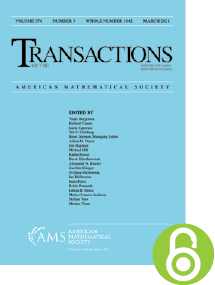Twisted face-pairing 3-manifolds
HTML articles powered by AMS MathViewer
- by J. W. Cannon, W. J. Floyd and W. R. Parry PDF
- Trans. Amer. Math. Soc. 354 (2002), 2369-2397 Request permission
Abstract:
This paper is an enriched version of our introductory paper on twisted face-pairing 3-manifolds. Just as every edge-pairing of a 2-dimensional disk yields a closed 2-manifold, so also every face-pairing $\epsilon$ of a faceted 3-ball $P$ yields a closed 3-dimensional pseudomanifold. In dimension 3, the pseudomanifold may suffer from the defect that it fails to be a true 3-manifold at some of its vertices. The method of twisted face-pairing shows how to correct this defect of the quotient pseudomanifold $P/\epsilon$ systematically. The method describes how to modify $P$ by edge subdivision and how to modify any orientation-reversing face-pairing $\epsilon$ of $P$ by twisting, so as to yield an infinite parametrized family of face-pairings $(Q,\delta )$ whose quotient complexes $Q/\delta$ are all closed orientable 3-manifolds. The method is so efficient that, starting even with almost trivial face-pairings $\epsilon$, it yields a rich family of highly nontrivial, yet relatively simple, 3-manifolds.
This paper solves two problems raised by the introductory paper:
(1) Replace the computational proof of the introductory paper by a conceptual geometric proof of the fact that the quotient complex $Q/\delta$ of a twisted face-pairing is a closed 3-manifold. We do so by showing that the quotient complex has just one vertex and that its link is the faceted sphere dual to $Q$.
(2) The twist construction has an ambiguity which allows one to twist all faces clockwise or to twist all faces counterclockwise. The fundamental groups of the two resulting quotient complexes are not at all obviously isomorphic. Are the two manifolds the same, or are they distinct?
We prove the highly nonobvious fact that clockwise twists and counterclockwise twists yield the same manifold. The homeomorphism between them is a duality homeomorphism which reverses orientation and interchanges natural 0-handles with 3-handles, natural 1-handles with 2-handles. This duality result of (2) is central to our further studies of twisted face-pairings.
We also relate the fundamental groups and homology groups of the twisted face-pairing 3-manifolds $Q/\delta$ and of the original pseudomanifold $P/\epsilon$ (with vertices removed).
We conclude the paper by giving examples of twisted face-pairing 3-manifolds. These examples include manifolds from five of Thurston’s eight 3-dimensional geometries.
References
- James W. Cannon, The combinatorial Riemann mapping theorem, Acta Math. 173 (1994), no. 2, 155–234. MR 1301392, DOI 10.1007/BF02398434
- J. W. Cannon, W. J. Floyd, and W. R. Parry, Squaring rectangles: the finite Riemann mapping theorem, The mathematical legacy of Wilhelm Magnus: groups, geometry and special functions (Brooklyn, NY, 1992) Contemp. Math., vol. 169, Amer. Math. Soc., Providence, RI, 1994, pp. 133–212. MR 1292901, DOI 10.1090/conm/169/01656
- J. W. Cannon, W. J. Floyd, and W. R. Parry, Sufficiently rich families of planar rings, Ann. Acad. Sci. Fenn. Math. 24 (1999), no. 2, 265–304. MR 1724092
- J. W. Cannon, W. J. Floyd, and W. R. Parry, Introduction to twisted face-pairings, Math. Res. Lett. 7 (2000), 477–491.
- J. W. Cannon, W. J. Floyd, and W. R. Parry, Ample twisted face-pairing 3-manifolds, preprint.
- J. W. Cannon, W. J. Floyd, and W. R. Parry, Heegaard diagrams and surgery descriptions for twisted face-pairing 3-manifolds, preprint.
- J. W. Cannon, W. J. Floyd, and W. R. Parry, A survey of twisted face-pairing 3-manifolds, in preparation.
- J. W. Cannon and E. L. Swenson, Recognizing constant curvature discrete groups in dimension $3$, Trans. Amer. Math. Soc. 350 (1998), no. 2, 809–849. MR 1458317, DOI 10.1090/S0002-9947-98-02107-2
- H. Seifert and W. Threlfall, Lehrbuch der Topologie, (Chelsea Publishing Company, New York 1947).
- W. P. Thurston, The Geometry and Topology of 3-Manifolds, Princeton lecture notes, http://www.msri.org/gt3m, 1979.
- William P. Thurston, Three-dimensional geometry and topology. Vol. 1, Princeton Mathematical Series, vol. 35, Princeton University Press, Princeton, NJ, 1997. Edited by Silvio Levy. MR 1435975
- J. Weeks, SnapPea: A computer program for creating and studying hyperbolic 3-manifolds, http://www.northnet.org/weeks.
Additional Information
- J. W. Cannon
- Affiliation: Department of Mathematics, Brigham Young University, Provo, Utah 84602
- Email: cannon@math.byu.edu
- W. J. Floyd
- Affiliation: Department of Mathematics, Virginia Tech, Blacksburg, Virginia 24061
- MR Author ID: 67750
- Email: floyd@math.vt.edu
- W. R. Parry
- Affiliation: Department of Mathematics, Eastern Michigan University, Ypsilanti, Michigan 48197
- MR Author ID: 136390
- Email: walter.parry@emich.edu
- Received by editor(s): December 8, 2000
- Received by editor(s) in revised form: October 5, 2001
- Published electronically: February 4, 2002
- Additional Notes: This research was supported in part by NSF grants DMS-9803868, DMS-9971783, and DMS-10104030
- © Copyright 2002 American Mathematical Society
- Journal: Trans. Amer. Math. Soc. 354 (2002), 2369-2397
- MSC (2000): Primary 57Mxx
- DOI: https://doi.org/10.1090/S0002-9947-02-02955-0
- MathSciNet review: 1885657


